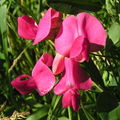Butterfly flower



The butterfly flower is the typical flower shape of the butterflies , whose flowers are flag flowers . The flowers are usually hermaphroditic, five-fold and zygomorphic , and their five petals are structured very differently. They are not to be confused with butterfly flowers , which specialize in pollination by butterflies . The flowers of the genus aconite ( aconite ) have a very similar structure.
features
The two lower petals are fused or at least glued together and form a keeled, boat-like tub, often bent upwards at the tip: the shuttle (Carina; Latin means "keel"). The stamens and the stylus lie in this shuttle. The stamens are mostly fused and hidden in the shuttle, typically in a diadelphic arrangement, but others are also possible.
The middle upper petal is usually enlarged and curved upwards (in the picture of the scented flat pea a little darker reddish). It is called a flag (vexillum).
The two lateral petals are overlapped by the flag and form the so-called wings (alae) to the left and right of the shuttle . Often they completely cover the boat. Wings and boats are often connected by a fold and thus offer approaching, flower-visiting insects a landing opportunity. Wings and shuttles are often so interlocked that landing bees and bumblebees release stamens and styluses for pollination.
Various pollination mechanisms are possible with butterfly flowers.
- Folding device; here, when a pollinator visits, the dust and carpel column emerges from the articulated, downward-folding boat and touches the animal and then returns again.
- Explosion device; here the tense stamens and carpels that are stuck together in the boat shoot out of the boat and do not return, so they can only be pollinated once.
- Pumping mechanism (pasta syringe); Here the pollen is first emptied into the tip of the boat and then in portions, through the thickened stamen ends or the anthers , when an insect visits, it is pressed out of the tip and also transported to the stigma of the flower (secondary pollen presentation).
- Brush devices; Here the pollen is first emptied onto a stylus brush ("pollen presenter") located below the scar and then transferred to the insects when the boat is folded up (secondary pollen presentation).
Flowers of the tuber pea . In the case of the flowers to the left of the center of the picture the boat protrudes to the left.
Sweet pea ( Lathyrus odoratus )
Finials
Finials (family of the Polygalaceae) have a similar flower shape with a boat, wing and flag. However, the wings are formed by two sepals similar to petals .
Individual evidence
- ^ Karl Smalian : Fundamentals of botany. 1st part: flowering plants. Freytag, 1910. (Salzwasser, 2013, ISBN 978-3-8460-3256-5 , p. 56 f.)
- ↑ Berthold Haller, Wilfried Probst: Botanical excursions. Volume II: Summer half year. Springer, 1989. (2016, ISBN 978-3-662-48687-0 , pp. 79-82.)

